Water Heater Service Valve
A water heater service valve is required to be installed into the cold water supply pipe that serves your water heater. Ordinarily only the water heater itself and then the hot water supply system are down stream of the service valve. There are a number of exceptions though.
Before I discuss the exceptions mentioned above I have a few things to say about the valve itself.
Older systems had what are called "Stops" as their water heater service valves. A stop is a valve that employs a seat and washer. The water must travel into the valve, flow to align with the port that the seat is milled into, through that port and past the washer and stem, to finally exit the valve into the down stream pipe. The port of the seat is never as large as the inlet and outlet pipes so not only is the water slowed by the path it must follow through the brass but flow is reduced and limited by the size of the port. This is inherent in the design of a stop valve.
Most of the stops one sees installed as water heater service valves are straight stops, occasionally one may see a ninety degree stop. In either case stops are directional valves, water must flow to the seat port side first, not the stem side. If a stop is installed backward the water will have access to the packing nut and packing gasket even when the valve is in the off position. Stops are rising stem valves so they do tend to have packing leaks, especially if they are used after years of no use. There is also the possibility that the washer will fail, making the valve much bless useful. Stops should have direction of flow indicated on them, usually arrows formed in the casting.
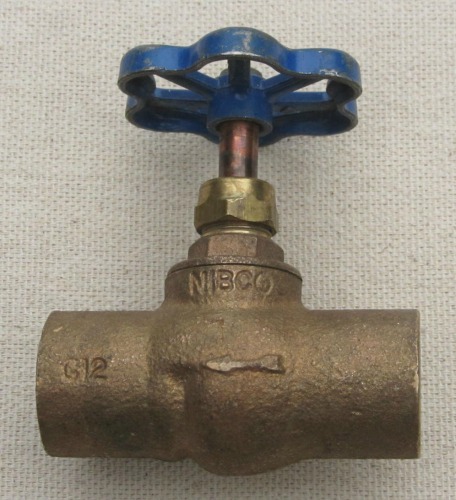 |
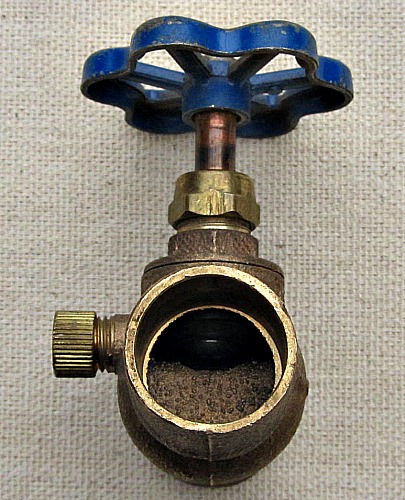 |
You can tell at a glance that this valve is a stop, (has a washer). The body does not have a place for a gate to rise into so it cannot be a gate valve and the handle is not a lever so it cannot be a ball valve.
The direction of flow is indicated on the brass and you can see the washer and washer screw, they also tell you that the photo displays the outlet, (downstream), side of the valve.
For many years the standard valve used as a control in residential plumbing systems was a "Gate" valve. Gate valves allow water to flow though them in a straight path. Not all gate valves are "full flow", there is typically some decrease in the diameter of the gate channel but it is never a significant reduction. Gate valves have non-rising stems so packing leaks are typically insignificant and easily controlled. There is a failure rate to consider with gate valves, especially with early imports. The water is held back by the perfect meeting of the brass surfaces, if they are imperfect or become marred by debris that becomes lodged in the valve the valve will not close 100%. When this happens the tendency is to force the valve off. More strength and even tools on the handle may be applied. The consequence of this may be a sheared off stem, inside or outside the valve, or a frozen gate that will not retract again. Either of these conditions call for the replacement of the valve.
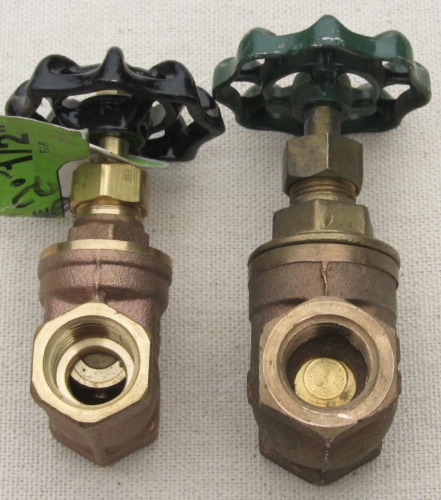 Here are a few gate valve photos, valve half closed, valve open, and packing nut backed off to show packing material. You can see the channel housing the gate retracts into. |
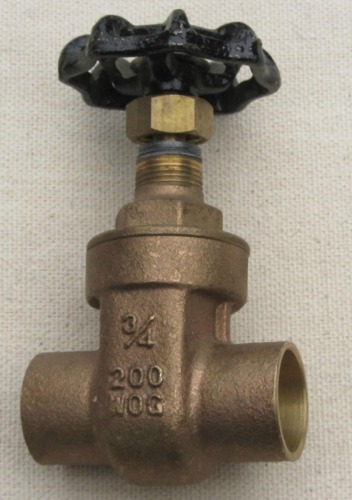 3/4 is the size, 200 is the pressure rating, and WOG indicates that the valve is rated for water, oil, or gas. |
This brings us to the present day. The "ball valve" is now the typical water heater service valve. There is a lot to like about ball valves. The sweep of the handle is ninety degrees from fully open to fully closed. Inherent in this design is the intuitive feature that allows one to see at a glance whether the valve is open or closed. When the handle aligns with the direction of flow the valve is open. Conversely when it is perpendicular to the direction of flow the valve is closed. Not all ball valves are full flow, but whether they are or not is obvious upon examination. The stem is sealed by an "O ring" under the packing nut, I have seen very few failures of these.
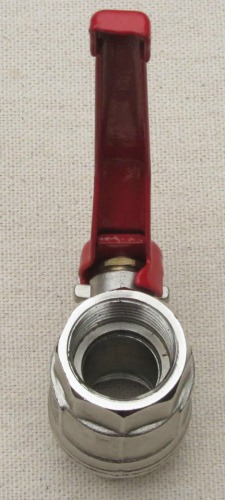 |
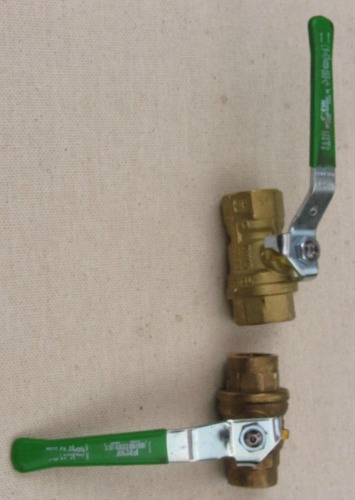 |
It is easy to see that the valve on the left is a full flow valve, it is also easy to see which valve on the right is open and which is closed. With the flow is open, against the flow is closed.
Downstream of the water heater service valve
As for the other systems and controls that may be installed downstream of the water heater service valve, they include:
The Thermal expansion tank is installed so that it may also be isolated by the water heater service valve.
The cold water inlet of the hot water recirculating system, though I prefer it to be installed into the boiler drain port. I install a tee there to fit the inlet and the drain valve and create more fall for my gravity powered recirculating system.
The cold water supply side for a tempering valve. Tempered water is part of the hot water system and so belongs entirely downstream of the water heater service valve.
Any secondary temperature and pressure relief valve, though water heaters universally have designated ports for TPRVs now.